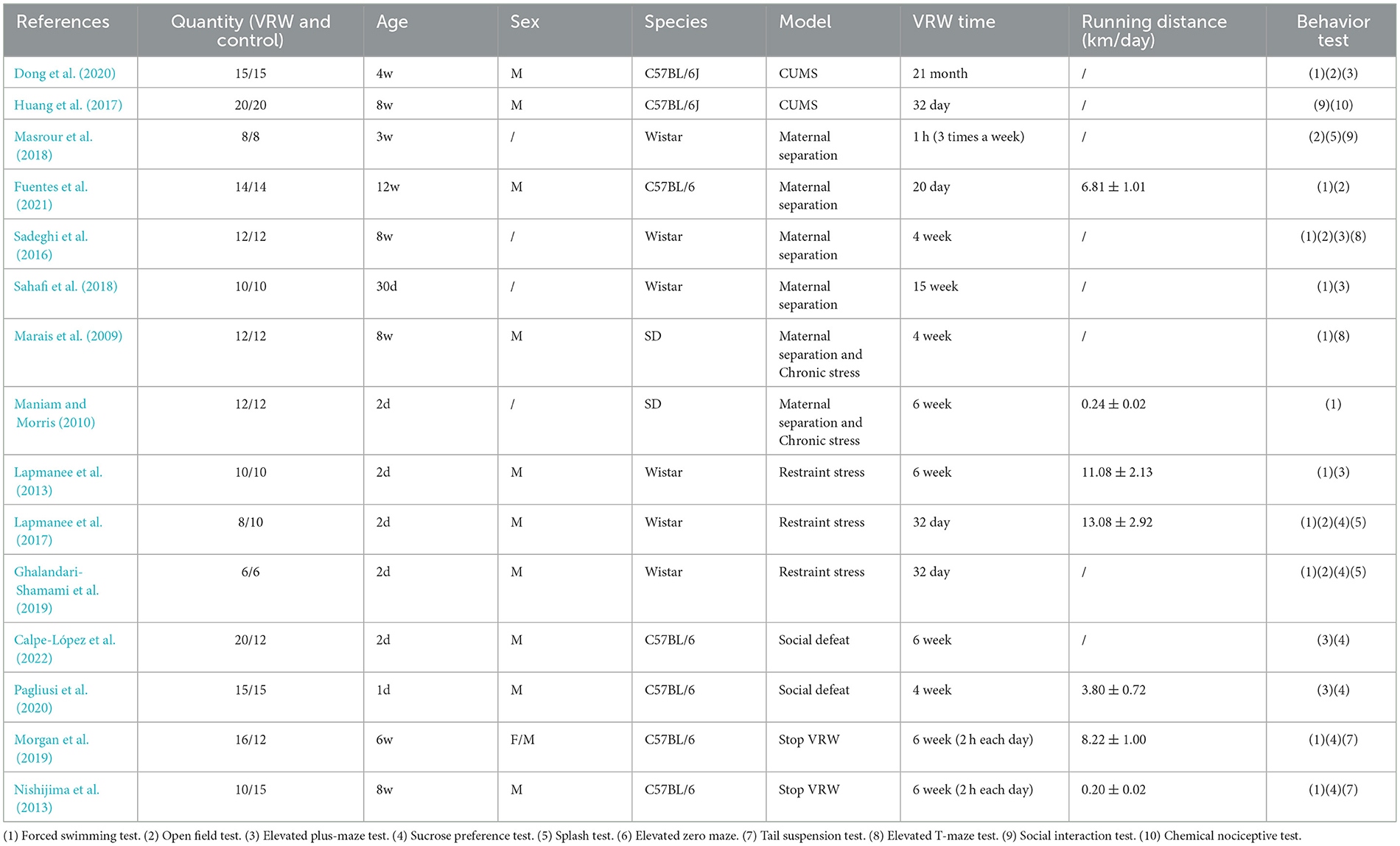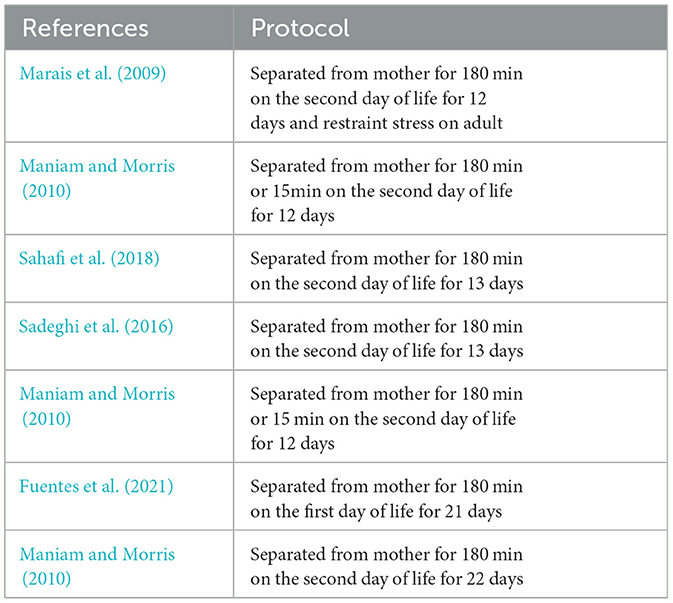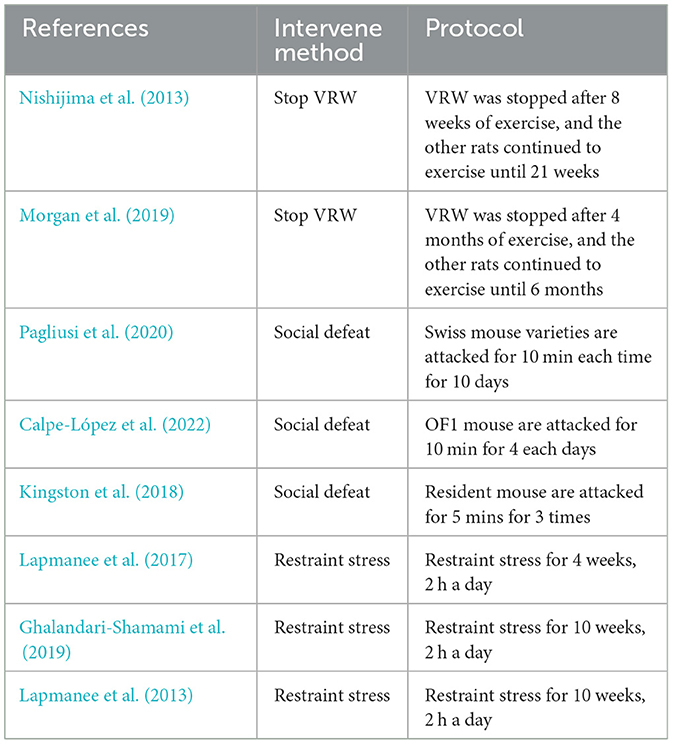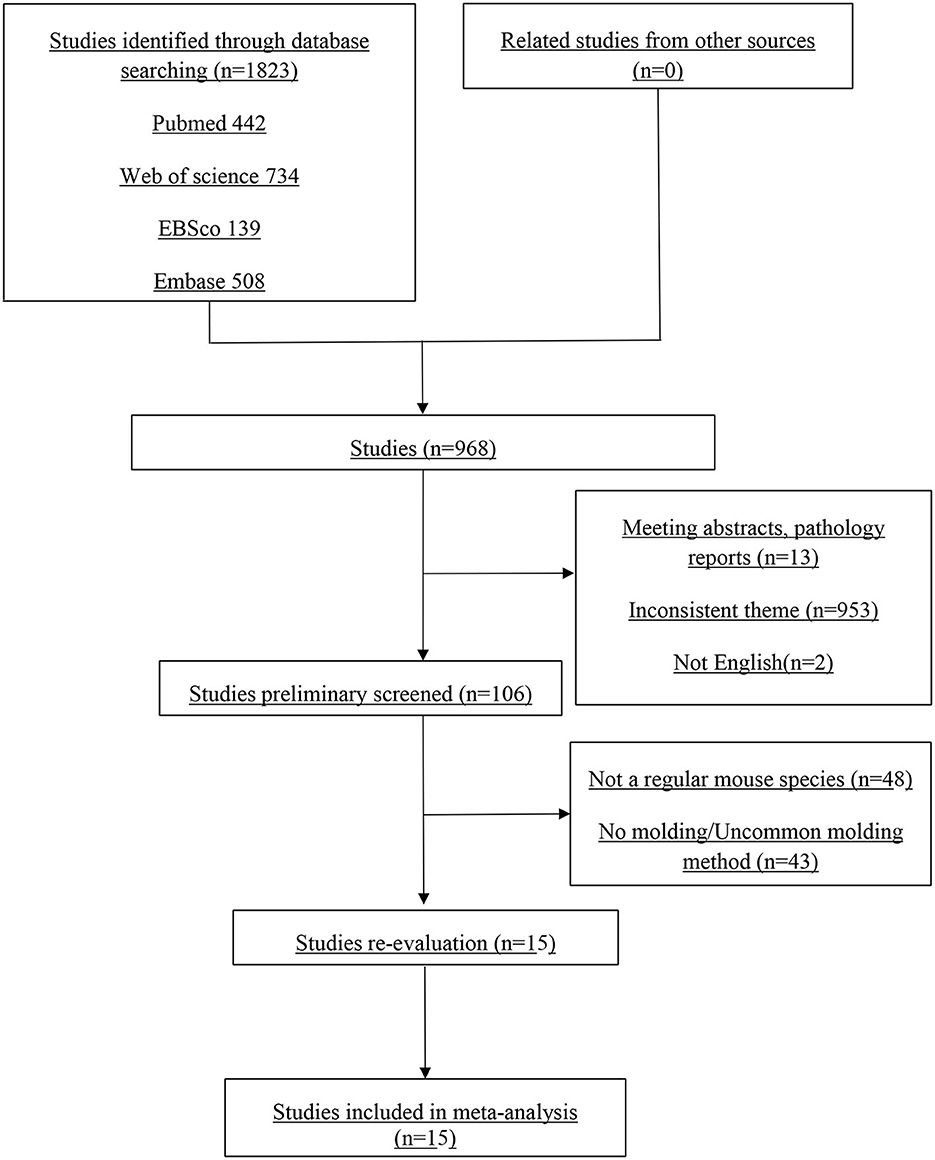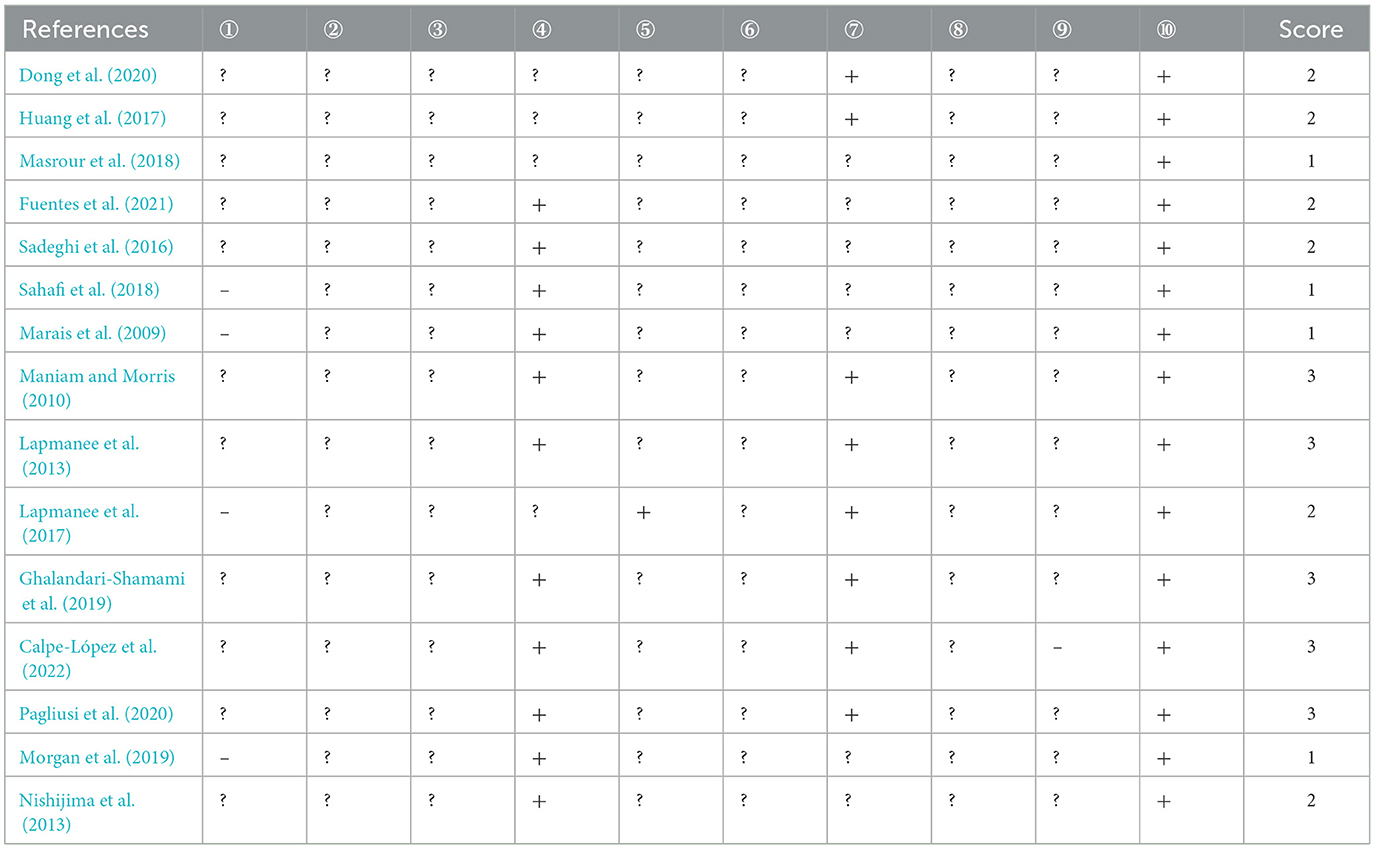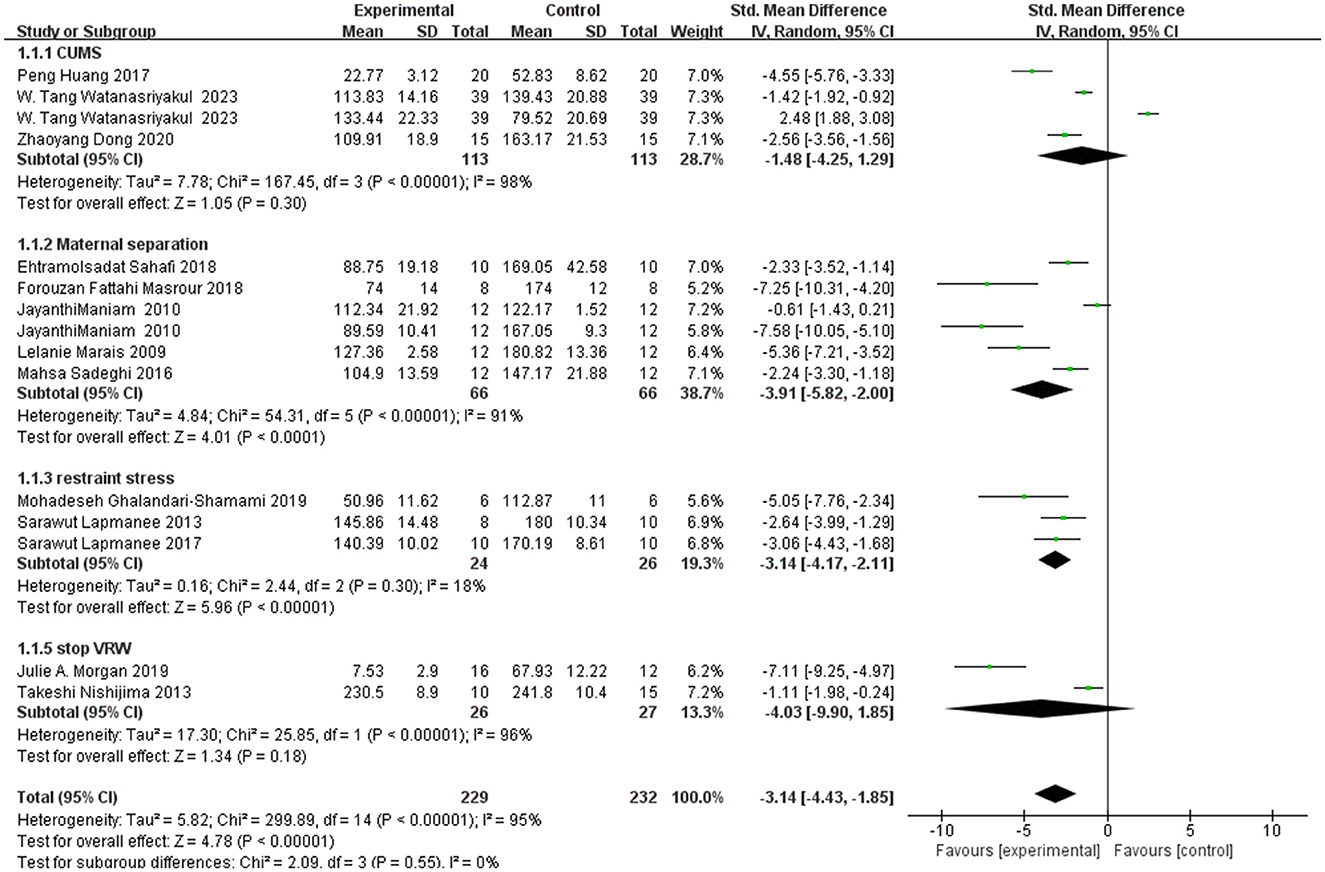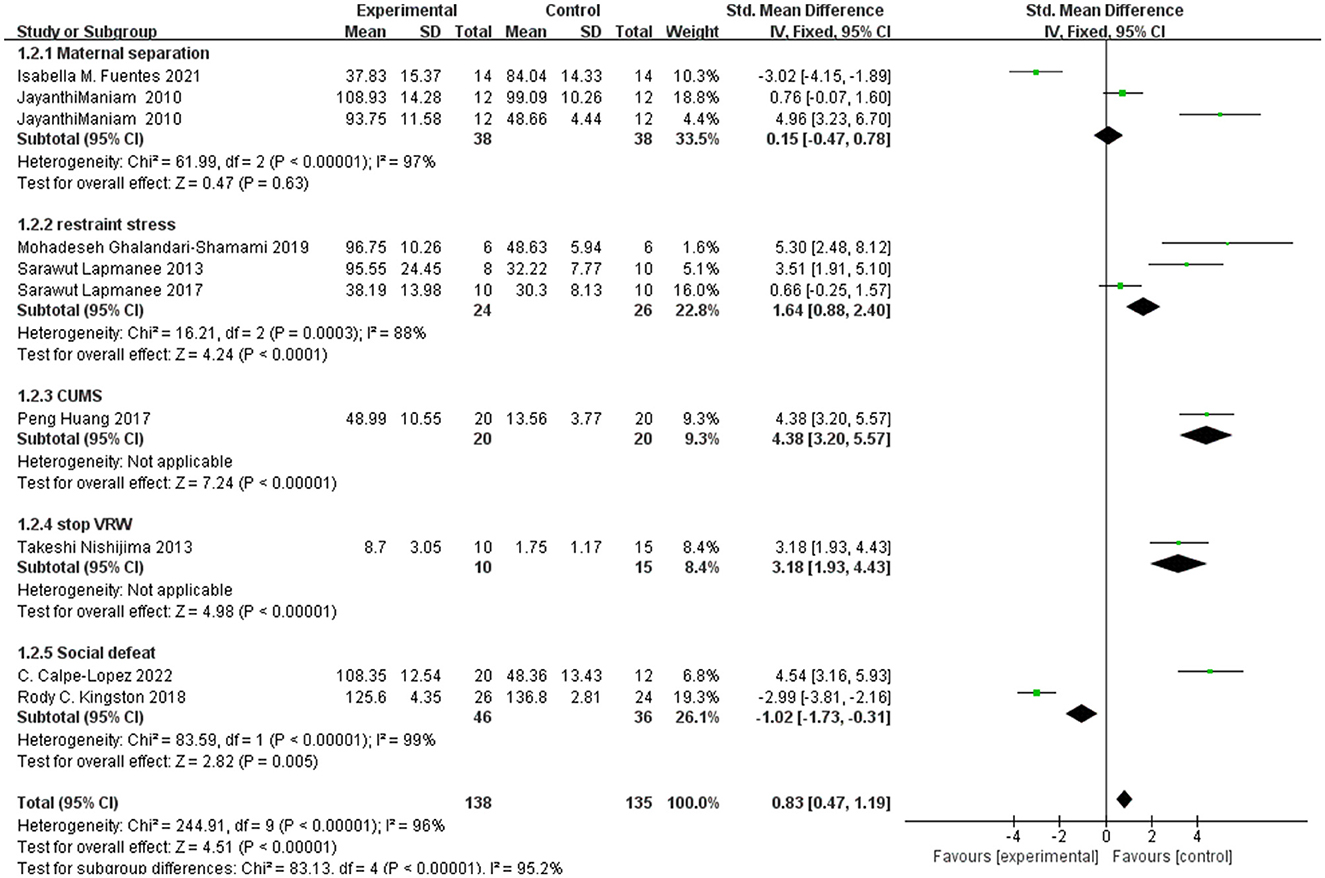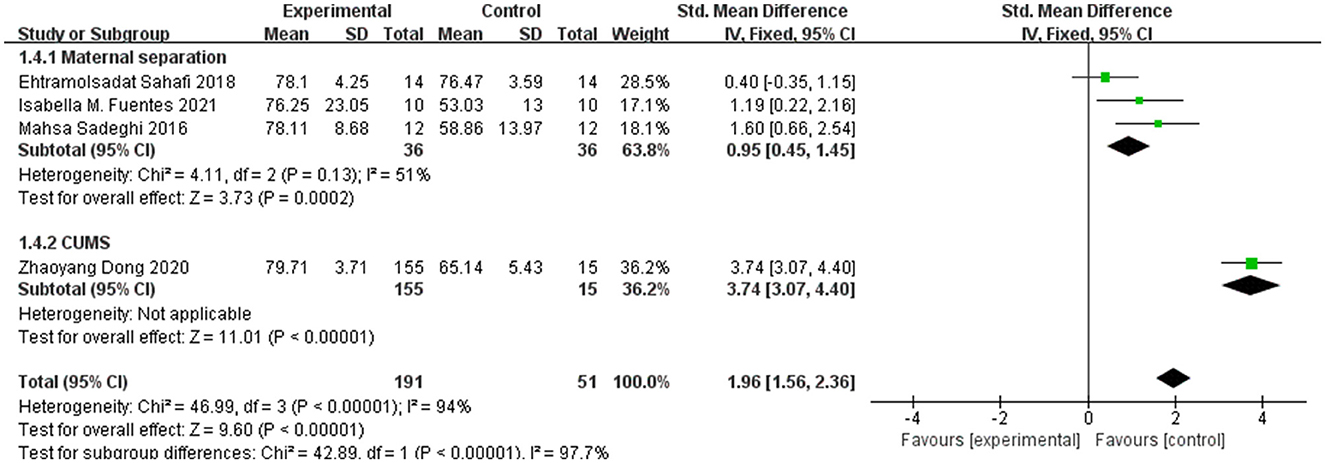- College of Sports Medicine and Rehabilitation, Beijing Sport University, Beijing, China
The effects of voluntary wheel-running exercise in different rodent models of depression remain unclear, and further research is needed to fully understand the mechanisms underlying these effects. Therefore, this systematic review aimed to evaluate the currently available findings on whether voluntary wheel-running exercise can alleviate depressive symptoms in five different rodent models of depression. The findings of the comprehensive meta-analysis imply that engaging in voluntary wheel-running exercise has a beneficial effect on alleviating depressive symptoms in rodent models that simulate depression. While further research is needed to fully understand the mechanisms and limitations of this intervention future research should aim to conduct larger. Well-designed studies that use standardized protocols and outcome measures. This would help to reduce heterogeneity between studies and improve the overall quality of the evidence base. Additionally, studies should explore the potential mechanisms of action of voluntary wheel-running exercise in treating depression, such as changes in neurotransmitter levels, neuroplasticity, and inflammation. The results suggest that it may hold promise as an adjunctive therapy for depression.
1 Introduction
The increasing prevalence of depression worldwide, with predictions of it becoming one of the top three burdensome diseases by 2030, underscores the urgent need for effective treatment options. The high recurrence rate of depression and its significant economic burden on individuals and society highlight the importance of finding new therapeutic approaches (Malhi and Mann, 2018; Mathers and Loncar, 2006; Zhdanava et al., 2021). Voluntary wheel-running exercise has emerged as a promising non-pharmacological intervention in animal models of depression. Its rewarding and voluntary nature, along with its ability to mimic natural running patterns and minimal stress on animals, make it an attractive option for long-term studies.
Several modeling methods exist to study depression, each simulating different stressors and scenarios that can lead to depressive symptoms. The Maternal Separation model focuses on early life trauma (Fellmeth et al., 2018; Liu et al., 2023; Ding et al., 2019), the CUMS model simulates work-related stress and sedentary lifestyles (Alreshidi and Rayani, 2023; Marzouk et al., 2018; Baglioni et al., 2016; Hoare et al., 2016; Lee and Kim, 2019), and the Social Defeat model mimics bullying and domestic violence (Husky et al., 2020; Azúa Fuentes et al., 2020). These models offer valuable insights into the complex nature of depression and its various triggers (Wu et al., 2020; Naghshvarian et al., 2017; Mul, 2018; Harro, 2019).
However, it remains unclear whether voluntary wheel-running exercise has a universal therapeutic effect across these different depression models. This meta-analysis aims to bridge this knowledge gap by synthesizing existing evidence on the potential benefits of voluntary wheel-running exercise for different depression models. By doing so, we hope to provide a more comprehensive understanding of the role of exercise in depression treatment and inform future research and clinical practice.
2 Materials and methods
2.1 Search and strategy
We searched English databases, such as PubMed, Web of Science, Embase, and EBSCOhost, to find relevant articles. The search was conducted from the establishment of the database until April 16, 2024. We used a combination of subject terms and free words tailored to each database's characteristics in our search. The English keywords we used were (“voluntaries”[All Fields] OR “voluntary”[All Fields]) AND (“depressed”[All Fields] OR “depression”[MeSH Terms] OR “depression”[All Fields] OR “depressions”[All Fields] OR “depressions”[All Fields] OR “depressive disorder”[MeSH Terms] OR (“depressive”[All Fields] AND “disorder”[All Fields]) OR “depressive disorder”[All Fields] OR “depressivity”[All Fields] OR “depressive”[All Fields] OR “depressively”[All Fields] OR “depressiveness”[All Fields] OR “depressives”[All Fields]).
2.2 Inclusion criteria
Inclusion criteria for this study: (1) different experimental rats and mice including C57BL/6J mice (213 cases), Wistar (110 cases) and SD rats (48 cases), (2) different depression models including chronic unpredictable mild stress (CUMS), maternal separation (MS), restraint stress, social defeat (SD) and Stop VRW, (3) behavior test including the forced swimming test (FST), sucrose preference test (SPT), and elevated plus maze (EPM) (Tables 1–3).
2.3 Exclusion criteria
(1) Studies that were not randomized controlled trials (RCTs), (2) incomplete data, (3) not obtain full-text data were excluded. (4) No behavioral test index (5) an unclear number of rodents, (6) no modeling process were also excluded.
2.4 Data extraction
After removing duplicates, studies that did not meet the inclusion criteria for language or design were excluded. Two researchers independently screened the resulting literature and extracted data according to the inclusion and exclusion criteria. The extracted data were cross-checked and decisions were made by two researchers. Any disagreements were resolved through discussions with a third researcher. The abstract includes the author, year, age of the participants, duration of the experiment, sample size, intervention measures, intervention duration, and outcome indicators (Naghshvarian et al., 2017).
2.5 Quality evaluation
Two researchers independently assessed the quality of the literature on 10 aspects using the SYRCLE Animal Experiment Risk Assessment Tool manual. If there were any disagreements, a third researcher was invited to make a judgment. To assess publication bias, we used a modified version of the SYRCLE Risk-of-Bias tool (Hooijmans et al., 2014). We assigned ratings of “+”, “–,” or “?” for each domain of the instrument. If the reported details were insufficient, we could assign internal and external validity scores to the studies included in the review. No studies were excluded based on quality evaluations.
3 Results
3.1 Literature search and screening
As shown in Figure 1, the study selection process involved a total of 1,832 articles initially. After removing duplicates, 968 papers remained. Subsequently, 15 articles were screened based on their titles and abstracts. After this screening process, the study design was reevaluated, and 15 full-text studies were deemed suitable for inclusion in this review and were considered in the meta-analysis.
3.2 Assessment of risk bias of included studies
The 15 studies included in the analysis were assessed using the SYRCLE bias risk tool, and 10 investigations were deemed suitable for inclusion. The evaluation resulted in a total score of 10 points, with each study receiving one point for low risk, as detailed in Table 4. The criteria used for evaluation were as follows: whether the allocation sequence was sufficiently/correctly generated or applied; whether the groups had the same baseline or adjusted for confounding factors; whether allocation hiding was sufficient/correct; whether the animals were randomly placed during the experiment; whether animal breeders and researchers were blinded to the interventions received by the animals; whether the animals in the outcome evaluation were randomly selected; whether the outcome assessors were blinded; whether incomplete data were adequately/correctly reported; whether the study report was related to selective outcome report; and whether there were no other issues that created a high risk of bias. The symbol “–” represents low risk; “+” represents high risk; and “?” represents uncertainty.
3.3 Meta-analysis
3.3.1 EPM
There was 97% heterogeneity in the MS group, 88% heterogeneity in the Restraint Stress group, 99% heterogeneity in the social defeat group, and no heterogeneity in the CUMS group or STOP VRW due to an insufficient number of articles. The final overall heterogeneity was 96%, and the results were significantly different [SMD = 0.83, 95% CI (0.47, 1.19)]. The confidence interval does not contain 0, indicating that there is a significant difference in effect between the two mean groups. Further details are shown in Figure 2.
3.3.2 FST
The overall heterogeneity between the study groups was I2 = 98%, which was >50%. Heterogeneity of 70% or higher indicates significant heterogeneity, making the results questionable. Heterogeneity of more than 70% means that researchers should consider not performing a meta-analysis of the results, as high heterogeneity may indicate that the effects shown in the meta-analysis are not valid. However, the heterogeneity of restraint stress was only 18% in the unpredictable mild stress stimulus (CUMS) group, 91% in the MS group, and 96% in the STOP-VRW group. The difference in the restraint stress immobility index after the exercise intervention was statistically significant [SMD = −3.14, CI (−4.17, −2.11)]. The confidence interval does not contain 0, indicating that there is a difference effect between the two groups of mean. The larger the area of the diamond square, the greater the weight in the analysis. Further details are shown in Figure 3.
3.3.3 SPT
Four articles tested the sucrose consumption index in SPT, with a 51% heterogeneity between MS groups. However, there were not enough articles to analyze the sucrose consumption index in CUMS. The data was analyzed using a random effects model. The sucrose consumption index was found to be higher in the observation group than in the control group [SMD = 1.96, 95% CI (1.56, 2.36)]. The confidence interval does not contain 0, indicating a significant difference between the mean values of the two groups. More details can be found in Figure 4.
4 Discussion
The systematic review and meta-analysis we have described highlights both the potential benefits of voluntary wheel running exercise for depression treatment across various modeling methods, as well as the challenges in interpreting the results due to high heterogeneity between studies. The finding that voluntary wheel running exercise had a significant effect on depression treatment, regardless of the modeling method used, is encouraging. It suggests that this non-pharmacological intervention may have broad applicability in addressing depression caused by different stressors and scenarios. However, the high heterogeneity between articles is a significant limitation that needs to be acknowledged. Heterogeneity in meta-analysis can arise from a variety of sources, including differences in study design, participant characteristics, intervention protocols, and outcome measures. This variability can make it difficult to draw definitive conclusions from the data and can reduce the accuracy and reliability of the results. To address this issue, future research should aim to standardize study protocols and outcome measures as much as possible. This would help reduce the heterogeneity between studies and improve the overall quality of the evidence base. Additionally, researchers should carefully consider the potential sources of heterogeneity in their meta-analysis and use statistical methods to account for it, such as sensitivity analyses or subgroup analyses.
Despite the limitations, the systematic review and meta-analysis we've described provides valuable insights into the potential role of voluntary wheel running exercise in depression treatment. The results suggest that this intervention may hold promise as an adjunctive therapy for depression, and further research is needed to explore its effectiveness and mechanisms of action.
4.1 Model characteristics and behavioral test
It is well-established that rodents cannot fill out questionnaires or scales to directly express their emotional states such as anxiety or helplessness, making the assessment of depression reliant on external behavioral analysis (Kroenke et al., 2009; Wang and Gorenstein, 2013), While behavioral tests provide a simple and efficient method of evaluating these emotional states, they do not always accurately reflect the degree of depression due to the potential for significant errors in interpretation (Harro, 2019). For instance, the forced swim test records of immobility, during which the animal initially tries to escape but eventually becomes immobile. This immobility may reflect a certain level of behavioral desperation. By observing and recording the immobility time of an animal in a state of desperation, we can understand the animal's response to external stress and assess the level of depression. We compared 10 studies to determine the immobility index during the forced swim test, which is an environment where the animal desperately tries to escape but is unable to do so, creating an inescapable stressful situation. After a certain period of time, the animal enters a typical “immobility state,” which can be used to evaluate the effects of antidepressants. The increased immobility time in rats during the forced swim test (FST) has been interpreted as a sign of despair, but it could also be a sign of adaptation to the water environment (Yankelevitch-Yahav et al., 2015). Several articles consistently report a duration of 5 min (Sahafi et al., 2018; Ghalandari-Shamami et al., 2019) immediately following the placement of water, whereas contrasting sources specify a slightly longer period of 6 min (Huang et al., 2017; Dong et al., 2020). Based on our personal testing result, it is evident that the stationary phase commences later in the timeline. Consequently, when converting the data, the stationary duration recorded in the articles indicating 6 min will exceed that of the 5-min timeframe. Similarly, the chronic unpredictable mild stress (CUMS) model, which involves exposing rats to various stressors, has been criticized for its lack of standardization and potential to yield abnormal results in the FST due to factors like cold and hot swimming. For example, Tatyana Strekalova suggests using the sucrose preference test (SPT) as a reasonable behavioral test method to evaluate anhedonia caused by CUMS (Strekalova et al., 2022). Additionally, classifying CUMS mice into “resilient” and “susceptible” cohorts can help provide more reasonable interpretations of behavioral test results (Antoniuk et al., 2019). The modeling process of CUMS varies widely among studies, making it difficult to widely promote the model without a unified protocol. Efforts have been made to standardize the modeling process and connect behavioral test results with depression models through reasonable interpretation. The open-field test and elevated plus-maze test have been found to be effective for evaluating the CUMS model, and it is recommended that other researchers also conduct this type of study (Hu et al., 2017). Andrea Raez offers a novel approach to analyzing behavioral tests by combining the FST with helplessness reactions to analyze their relationship (Ráez et al., 2020). In summary, while behavioral tests are valuable tools for evaluating emotional states in rats and mice, their interpretation must be approached with caution due to the potential for errors and variability. Future research should focus on standardizing modeling protocols, developing new behavioral tests, and refining interpretation methods to improve the accuracy and reliability of depression models in rodents.
4.2 Voluntary wheel-running exercise
In general, exercise has been shown to exert profound effects on the nervous system, contributing to the alleviation of depression (Cotman and Berchtold, 2002; Ma, 2008). Voluntary exercise, a subject of increasing interest in recent years, has not been as extensively studied as forced exercise, though it has been explored in terms of factors such as BDNF (Bastioli et al., 2022), tyrosine hydroxylase-positive neuron (Tsai et al., 2019) and plasma kynurenine (KYN) level (Su et al., 2020) Voluntary wheel running, a more natural form of exercise, offers the distinct advantage of providing more effective rewarding feedback (Mul, 2018; Stranahan et al., 2008), which is associated with activation of both the sympathetic nervous system, leading to epinephrine production, and the hypothalamic-pituitary-adrenal (HPA) axis. However, the precise mechanisms underlying these effects remain elusive (Richter et al., 2014). In comparison to forced exercise, voluntary wheel running is characterized by significantly faster speeds, with some mice running several times faster over the same distance (Leasure and Jones, 2008). With regards to movement distance, the study revealed considerable variability among mice, both within and between strain. Body size contributed to the differences in movement distances between large and small mice, yet significant variations were also observed within the same mouse strain. For instance, while the least active C57BL/6 mice moved an average of only 0.2 km/day, the most active ones traveled as much as 6.8 km/day. Interestingly, all mice in the study exhibited an increase in their weekly movement distance, with the exception of one SD rat that not only moved minimally (0.24 km/day) but also showed a decreasing trend in movement distance. This particular rat was suspected to be high-fat-fed, and its declining willingness to engage in voluntary movement was likely due to obesity-induced changes in the brain that reduced its motivation to move (Maniam and Morris, 2010). Overall, the findings suggest that free running on a treadmill may be beneficial in ameliorating symptoms of depression or anxiety. However, whether the length of the running distance has a definitive impact on depression remains an open question that necessitates further experimental investigation.
Data availability statement
The raw data supporting the conclusions of this article will be made available by the authors, without undue reservation.
Author contributions
HS: Writing – original draft, Writing – review & editing. XL: Supervision, Writing – review & editing. JZ: Supervision, Writing – review & editing. XZ: Writing – review & editing.
Funding
The author(s) declare financial support was received for the research, authorship, and/or publication of this article. This work was supported by National Natural Science Foundation of China (No. 82202822), Fundamental Research Funds for the Central Universities (No. 2022QN002), and Fundamental Research Funds for the Central Universities (Exercise Rehabilitation Science Laboratory).
Conflict of interest
The authors declare that the research was conducted in the absence of any commercial or financial relationships that could be construed as a potential conflict of interest.
Publisher's note
All claims expressed in this article are solely those of the authors and do not necessarily represent those of their affiliated organizations, or those of the publisher, the editors and the reviewers. Any product that may be evaluated in this article, or claim that may be made by its manufacturer, is not guaranteed or endorsed by the publisher.
Supplementary material
The Supplementary Material for this article can be found online at: https://www.frontiersin.org/articles/10.3389/fnbeh.2024.1435891/full#supplementary-material
References
Alreshidi, S. M., and Rayani, A. M. (2023). The correlation between night shift work schedules, sleep quality, and depression symptoms. Neuropsychiatr. Dis. Treat. 19, 1565–1571. doi: 10.2147/NDT.S421092
Antoniuk, S., Bijata, M., Ponimaskin, E., and Wlodarczyk, J. (2019). Chronic unpredictable mild stress for modeling depression in rodents: meta-analysis of model reliability. Neurosci. Biobehav. Rev. 99, 101–116. doi: 10.1016/j.neubiorev.2018.12.002
Azúa Fuentes, E., Rojas Carvallo, P., and Ruiz Poblete, S. (2020). Bullying as a risk factor for depression and suicide. Rev. Child Pediatr. 91, 432–439. doi: 10.32641/rchped.v91i3.1230
Baglioni, C., Nanovska, S., Regen, W., Spiegelhalder, K., Feige, B., Nissen, C., et al. (2016). Sleep and mental disorders: a meta-analysis of polysomnographic research. Psychol. Bull. 142, 969–990. doi: 10.1037/bul0000053
Bastioli, G., Arnold, J. C., Mancini, M., Mar, A. C., Gamallo-Lana, B., Saadipour, K., et al. (2022). Voluntary exercise boosts striatal dopamine release: evidence for the necessary and sufficient role of BDNF. J. Neurosci. 42, 4725–4736. doi: 10.1523/JNEUROSCI.2273-21.2022
Calpe-López, C., Martínez-Caballero, M. A., García-Pardo, M. P., and Aguilar, M. A. (2022). Intermittent voluntary wheel running promotes resilience to the negative consequences of repeated social defeat in mice. Physiol. Behav. 254, 113–116. doi: 10.1016/j.physbeh.2022.113916
Cotman, C. W., and Berchtold, N. C. (2002). Exercise: a behavioral intervention to enhance brain health and plasticity. Trends Neurosci. 25, 295–301. doi: 10.1016/S0166-2236(02)02143-4
Ding, L., Yuen, L. W., Buhs, E. S., and Newman, I. M. (2019). Depression among Chinese Left-behind children: a systematic review and meta-analysis. Child. Care Health Dev. 45, 189–197. doi: 10.1111/cch.12642
Dong, Z., Liu, Z., Liu, Y., Zhang, R., Mo, H., Gao, L., et al. (2020). Physical exercise rectifies CUMS-induced aberrant regional homogeneity in mice accompanied by the adjustment of skeletal muscle PGC-1a/IDO1 signals and hippocampal function. Behav. Brain Res. 383:112516. doi: 10.1016/j.bbr.2020.112516
Fellmeth, G., Rose-Clarke, K., Zhao, C., Busert, L. K., Zheng, Y., Massazza, A., et al. (2018). Health impacts of parental migration on left-behind children and adolescents: a systematic review and meta-analysis. Lancet 392, 2567–2582. doi: 10.1016/S0140-6736(18)32558-3
Fuentes, I. M., Jones, B. M., Brake, A. D., Pierce, A. N., Eller, O. C., Supple, R. M., et al. (2021). Voluntary wheel running improves outcomes in an early life stress-induced model of urologic chronic pelvic pain syndrome in male mice. Pain 162, 1681–1691. doi: 10.1097/j.pain.0000000000002178
Ghalandari-Shamami, M., Nourizade, S., Yousefi, B., Vafaei, A. A., Pakdel, R., Rashidy-Pour, A., et al. (2019). Beneficial effects of physical activity and crocin against adolescent stress induced anxiety or depressive-like symptoms and dendritic morphology remodeling in prefrontal cortex in adult male rats. Neurochem. Res. 44, 917–929. doi: 10.1007/s11064-019-02727-2
Harro, J. (2019). Animal models of depression: pros and cons. Cell Tissue Res. 377, 5–20. doi: 10.1007/s00441-018-2973-0
Hoare, E., Milton, K., Foster, C., and Allender, S. (2016). The associations between sedentary behaviour and mental health among adolescents: a systematic review. Int. J. Behav. Nutr. Phys. Act. 13:108. doi: 10.1186/s12966-016-0432-4
Hooijmans, C. R., Rovers, M. M., De Vries, R. B., Leenaars, M., Ritskes-Hoitinga, M., Langendam, M. W., et al. (2014). SYRCLE's risk of bias tool for animal studies. BMC Med Res Methodol. 14:43. doi: 10.1186/1471-2288-14-43
Hu, C., Luo, Y., Wang, H., Kuang, S., Liang, G., Yang, Y., et al. (2017). Re-evaluation of the interrelationships among the behavioral tests in rats exposed to chronic unpredictable mild stress. PLoS ONE 12:e0185129. doi: 10.1371/journal.pone.0185129
Huang, P., Dong, Z., Huang, W., Zhou, C., Zhong, W., Hu, P., et al. (2017). Voluntary wheel running ameliorates depression-like behaviors and brain blood oxygen level-dependent signals in chronic unpredictable mild stress mice. Behav. Brain Res. 330, 17–24. doi: 10.1016/j.bbr.2017.05.032
Husky, M. M., Delbasty, E., Bitfoi, A., Carta, M. G., Goelitz, D., Koç, C., et al. (2020). Bullying involvement and self-reported mental health in elementary school children across Europe. Child Abuse Negl. 107:104601. doi: 10.1016/j.chiabu.2020.104601
Kingston, R. C., Smith, M., Lacey, T., Edwards, M., Best, J. N., Markham, C. M., et al. (2018). Voluntary exercise increases resilience to social defeat stress in Syrian hamsters. Physiol. Behav. 188, 194–198. doi: 10.1016/j.physbeh.2018.02.003
Kroenke, K., Strine, T. W., Spitzer, R. L., Williams, J. B., Berry, J. T., Mokdad, A. H., et al. (2009). The PHQ-8 as a measure of current depression in the general population. J. Affect Disord. 114, 163–73. doi: 10.1016/j.jad.2008.06.026
Lapmanee, S., Charoenphandhu, J., and Charoenphandhu, N. (2013). Beneficial effects of fluoxetine, reboxetine, venlafaxine, and voluntary running exercise in stressed male rats with anxiety- and depression-like behaviors. Behav. Brain Res. 250, 316–325. doi: 10.1016/j.bbr.2013.05.018
Lapmanee, S., Charoenphandhu, J., Teerapornpuntakit, J., Krishnamra, N., and Charoenphandhu, N. (2017). Agomelatine, venlafaxine, and running exercise effectively prevent anxiety- and depression-like behaviors and memory impairment in restraint stressed rats. PLoS ONE 12:e0187671. doi: 10.1371/journal.pone.0187671
Leasure, J. L., and Jones, M. (2008). Forced and voluntary exercise differentially affect brain and behavior. Neuroscience 156, 456–465. doi: 10.1016/j.neuroscience.2008.07.041
Lee, E., and Kim, Y. (2019). Effect of university students' sedentary behavior on stress, anxiety, and depression. Perspect. Psychiatr. Care 55, 164–169. doi: 10.1111/ppc.12296
Liu, W., Wang, Y., Xia, L., Wang, W., Li, Y., Liang, Y., et al. (2023). Left-behind children's positive and negative social adjustment: a qualitative study in China. Behav. Sci. 13:341. doi: 10.3390/bs13040341
Ma, Q. (2008). Beneficial effects of moderate voluntary physical exercise and its biological mechanisms on brain health. Neurosci. Bull. 24, 265–270. doi: 10.1007/s12264-008-0402-1
Malhi, G. S., and Mann, J. J. (2018). Depression. Lancet 392, 2299–2312. doi: 10.1016/S0140-6736(18)31948-2
Maniam, J., and Morris, M. J. (2010). Voluntary exercise and palatable high-fat diet both improve behavioural profile and stress responses in male rats exposed to early life stress: role of hippocampus. Psychoneuroendocrinology 35, 1553–1564. doi: 10.1016/j.psyneuen.2010.05.012
Marais, L., Stein, D. J., and Daniels, W. M. (2009). Exercise increases BDNF levels in the striatum and decreases depressive-like behavior in chronically stressed rats. Metab. Brain Dis. 24, 587–597. doi: 10.1007/s11011-009-9157-2
Marzouk, M., Ouanes-Besbes, L., Ouanes, I., Hammouda, Z., Dachraoui, F., Abroug, F., et al. (2018). Prevalence of anxiety and depressive symptoms among medical residents in Tunisia: a cross-sectional survey. BMJ Open 8:e020655. doi: 10.1136/bmjopen-2017-020655
Masrour, F. F., Peeri, M., Azarbayjani, M. A., and Hosseini, M. J. (2018). Voluntary exercise during adolescence mitigated negative the effects of maternal separation stress on the depressive-like behaviors of adult male rats: role of NMDA receptors. Neurochem. Res. 43, 1067–1074. doi: 10.1007/s11064-018-2519-6
Mathers, C. D., and Loncar, D. (2006). Projections of global mortality and burden of disease from 2002 to 2030. PLoS Med. 3:e442. doi: 10.1371/journal.pmed.0030442
Morgan, J. A., Singhal, G., Corrigan, F., Jaehne, E. J., Jawahar, M. C., Breen, J., et al. (2019). Ceasing exercise induces depression-like, anxiety-like, and impaired cognitive-like behaviours and altered hippocampal gene expression. Brain Res. Bull. 148, 118–130. doi: 10.1016/j.brainresbull.2019.02.014
Mul, J. D. (2018). Voluntary exercise and depression-like behavior in rodents: are we running in the right direction? J. Mol. Endocrinol. 60, R77–R95. doi: 10.1530/JME-17-0165
Naghshvarian, M., Zarrindast, M. R., and Sajjadi, S. F. (2017). Voluntary wheel running induces exercise-seeking behavior in male rats: a behavioral study. Arch. Iran. Med. 20, 740–745.
Nishijima, T., Llorens-Martín, M., Tejeda, G. S., Inoue, K., Yamamura, Y., Soya, H., et al. (2013). Cessation of voluntary wheel running increases anxiety-like behavior and impairs adult hippocampal neurogenesis in mice. Behav. Brain Res. 245, 34–41. doi: 10.1016/j.bbr.2013.02.009
Pagliusi, M. Jr., Bonet, I. J. M., Brandão, A. F., Magalhães, S. F., Tambeli, C. H., Parada, C. A., et al. (2020). Therapeutic and preventive effect of voluntary running wheel exercise on social defeat stress (SDS)-induced depressive-like behavior and chronic pain in mice. Neuroscience 428, 165–177. doi: 10.1016/j.neuroscience.2019.12.037
Ráez, A., Oliveras, I., Río-Álamos, C., Díaz-Morán, S., Cañete, T., Blázquez, G., et al. (2020). A missing link between depression models: forced swimming test, helplessness and passive coping in genetically heterogeneous NIH-HS rats. Behav. Processes 177:104142. doi: 10.1016/j.beproc.2020.104142
Richter, S. H., Gass, P., and Fuss, J. (2014). Resting is rusting: a critical view on rodent wheel-running behavior. Neuroscientist 20, 313–325. doi: 10.1177/1073858413516798
Sadeghi, M., Peeri, M., and Hosseini, M. J. (2016). Adolescent voluntary exercise attenuated hippocampal innate immunity responses and depressive-like behaviors following maternal separation stress in male rats. Physiol. Behav. 163, 177–183. doi: 10.1016/j.physbeh.2016.05.017
Sahafi, E., Peeri, M., Hosseini, M. J., and Azarbayjani, M. A. (2018). Cardiac oxidative stress following maternal separation stress was mitigated following adolescent voluntary exercise in adult male rat. Physiol Behav. 183, 39–45. doi: 10.1016/j.physbeh.2017.10.022
Stranahan, A. M., Lee, K., and Mattson, M. P. (2008). Central mechanisms of HPA axis regulation by voluntary exercise. Neuromolecular Med. 10, 118–227. doi: 10.1007/s12017-008-8027-0
Strekalova, T., Liu, Y., Kiselev, D., Khairuddin, S., Chiu, J. L. Y., Lam, J., et al. (2022). Chronic mild stress paradigm as a rat model of depression: facts, artifacts, and future perspectives. Psychopharmacology 239, 663–693. doi: 10.1007/s00213-021-05982-w
Su, C. H., Chuang, H. C., and Hong, C. J. (2020). Physical exercise prevents mice from L-Kynurenine-induced depression-like behavior. Asian J. Psychiatr. 48:101894. doi: 10.1016/j.ajp.2019.101894
Tsai, W. L., Chen, H. Y., Huang, Y. Z., Chen, Y. H., Kuo, C. W., Chen, K. Y., et al. (2019). Long-term voluntary physical exercise exerts neuroprotective effects and motor disturbance alleviation in a rat model of Parkinson's disease. Behav. Neurol. 2019:4829572. doi: 10.1155/2019/4829572
Wang, Y. P., and Gorenstein, C. (2013). Psychometric properties of the Beck Depression Inventory-II: a comprehensive review. Braz. J. Psychiatry 35, 416–31. doi: 10.1590/1516-4446-2012-1048
Wu, C., Yang, L., Li, Y., Dong, Y., Yang, B., Tucker, L. D., et al. (2020). Effects of exercise training on anxious-depressive-like behavior in Alzheimer rat. Med Sci Sports Exerc. 52, 1456–1469. doi: 10.1249/MSS.0000000000002294
Yankelevitch-Yahav, R., Franko, M., Huly, A., and Doron, R. (2015). The forced swim test as a model of depressive-like behavior. J. Vis. Exp. e52587. doi: 10.3791/52587
Keywords: voluntary wheel-running exercise, depression models, forced swimming test, sucrose preference test, elevated plus maze
Citation: Shen H, Li X, Zhai J and Zhang X (2024) Voluntary wheel-running exercise improvement of anxiety or depressive symptoms in different models of depression. Front. Behav. Neurosci. 18:1435891. doi: 10.3389/fnbeh.2024.1435891
Received: 21 May 2024; Accepted: 27 September 2024;
Published: 15 October 2024.
Edited by:
Yingjie Zhu, Chinese Academy of Sciences (CAS), ChinaReviewed by:
Robert Parrish Waters, University of Mary Washington, United StatesVirginie Rappeneau, University of Regensburg, Germany
Copyright © 2024 Shen, Li, Zhai and Zhang. This is an open-access article distributed under the terms of the Creative Commons Attribution License (CC BY). The use, distribution or reproduction in other forums is permitted, provided the original author(s) and the copyright owner(s) are credited and that the original publication in this journal is cited, in accordance with accepted academic practice. No use, distribution or reproduction is permitted which does not comply with these terms.
*Correspondence: Xuemei Li, bHhtXzIwMDM5MTZAMTI2LmNvbQ==
 Haodi Shen
Haodi Shen Xuemei Li
Xuemei Li Junyao Zhai
Junyao Zhai Xin Zhang
Xin Zhang